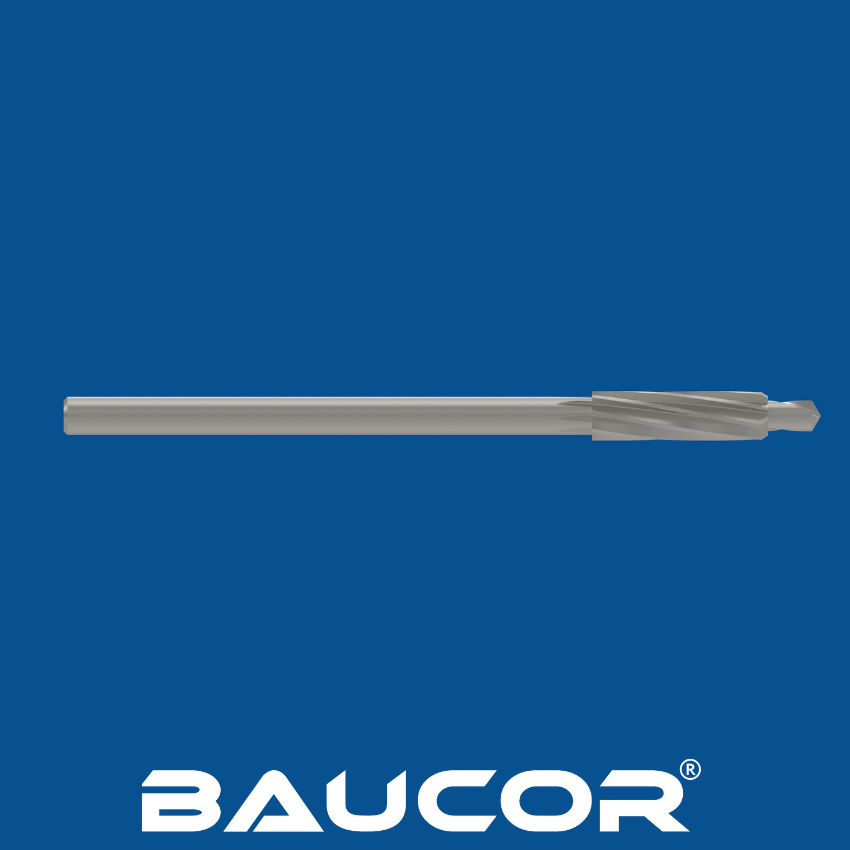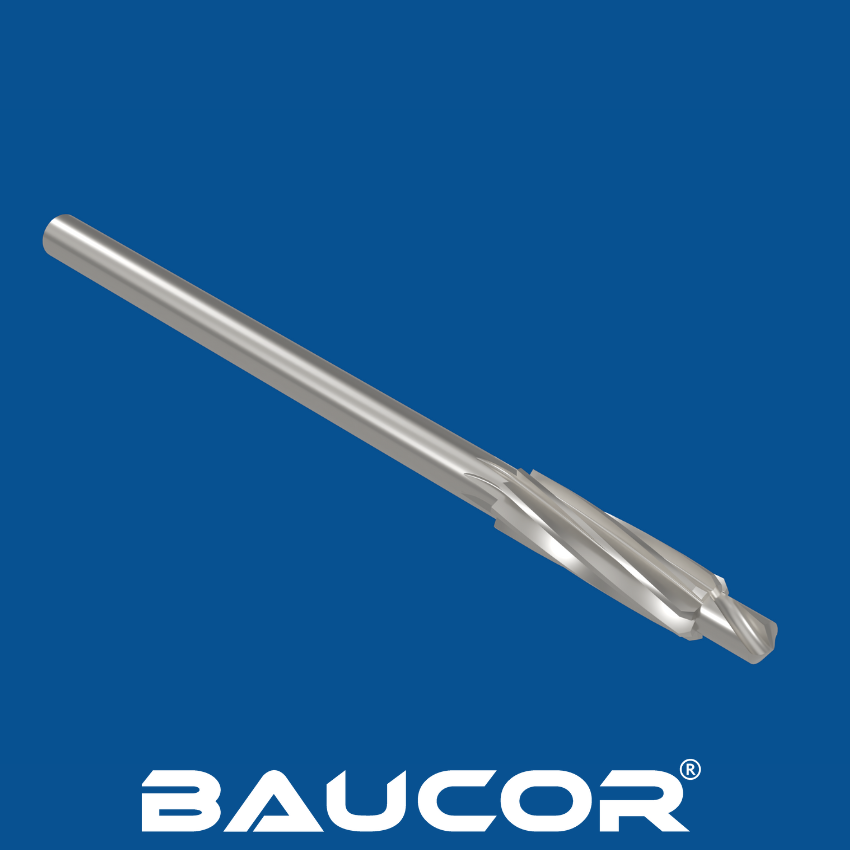BAUCOR REAMERS: UNLEASH THE POWER OF PRECISION.
EXPERIENCE ENHANCED PERFORMANCE, SUPERIOR SURFACE FINISH, AND UNMATCHED DURABILITY.
BAUCOR REAMERS: UNLEASH THE POWER OF PRECISION.
EXPERIENCE ENHANCED PERFORMANCE, SUPERIOR SURFACE FINISH, AND UNMATCHED DURABILITY.
Combination drill and reamers, also known as combined drills and reamers or drill/reamers, are versatile cutting tools designed to perform both drilling and reaming operations in a single pass. This unique design eliminates the need to change tools, saving time and improving efficiency in machining processes.
How Combination Drill and Reamers Work
The cutting action of a combination drill and reamer is a two-step process:
As the combination drill and reamer is fed into the workpiece, the drill section creates the initial hole, and the reamer section immediately follows, enlarging and finishing the hole in one continuous operation. This eliminates the need to stop the machine, change tools, and then resume the machining process, saving valuable time and reducing the risk of errors.

The manufacturing of combination drill and reamers (also known as combined drills and reamers or drill/reamers) involves a precise multi-step process to ensure both drilling and reaming functions are performed accurately and efficiently:
Material Selection:
Blank Preparation:
Machining the Drill Section:
Machining the Reamer Section:
Heat Treatment:
Grinding:
Coating (Optional):
Inspection and Quality Control:
By following these steps and employing precise manufacturing techniques, manufacturers can produce high-quality combination drill and reamers that deliver reliable and efficient performance in drilling and reaming operations. These tools offer a convenient and cost-effective solution for applications where both drilling and reaming are required in a single pass.

As a leading manufacturer of cutting tools, Baucor likely offers a wide range of combination drill and reamer sizes to cater to the diverse needs of their customers across various industries. While their specific product catalog may vary, you can expect the following size ranges:
Fractional Sizes (Inch):
Metric Sizes (Millimeter):
Standard: A broad selection of metric sizes, likely starting from 1mm, 1.5mm, 2mm, 2.5mm, and progressing to larger diameters like 10mm, 12mm, or even higher, catering to users who prefer metric measurements.
Additional Considerations:
Obtaining Precise Information:
To obtain the most accurate and up-to-date information on the specific sizes of combination drill and reamers manufactured by Baucor, it is recommended to:
By utilizing these resources, you can ensure that you select the perfect Baucor combination drill and reamer size for your drilling and reaming applications.
Combination drill and reamers are manufactured using various materials, each with its own advantages and ideal applications:
Common Materials:
Other Materials:
Additional Considerations:
Choosing the right material for a combination drill and reamer depends on the specific application, the workpiece material, the desired surface finish, and budget considerations. For most general-purpose applications, HSS is a suitable and cost-effective choice. However, for harder materials or demanding applications, cobalt or carbide tools may be more appropriate.

Reamers with blades that can be adjusted to slightly vary the hole size.

Long reamers used to accurately ream holes in bridge construction.

Reamers specifically designed for use in automotive manufacturing.

Tools that combine a drill and a reamer in one.
Combination drill and reamers, like other cutting tools, can be enhanced with various coatings to improve their performance, tool life, and versatility. Here are the common and specialized coatings used:
Common Coatings:
Specialized Coatings:
Choosing the Right Coating:
The ideal coating for a combination drill and reamer depends on several factors, including:
Consulting with the tool manufacturer or a knowledgeable supplier can help you select the optimal coating for your specific needs. By considering the material, machining conditions, and desired tool life, you can ensure that your combination drill and reamer delivers the best possible performance and longevity.
Combination drill and reamers, also known as combined drills and reamers or drill/reamers, are versatile tools used in a variety of industries and applications where precise and smooth holes are required with efficiency. Their ability to perform both drilling and reaming in a single operation saves time and improves productivity.
Key Industries:
Specific Applications:
In summary, combination drill and reamers are valuable tools that find applications in various industries and tasks where efficient and precise hole creation is essential. Their ability to combine drilling and reaming operations into a single step makes them a valuable asset for improving productivity and reducing costs in machining processes.
Combination drill and reamers are versatile tools used in a variety of industries where efficient and precise hole creation is essential. Their ability to drill and ream in a single operation makes them valuable for streamlining production processes and reducing tooling costs. Here are some of the key industries that utilize combination drill and reamers:
In addition to these industries, combination drill and reamers are also used in various maintenance and repair applications, where worn or damaged holes need to be drilled out and reamed to the correct size. Their versatility and efficiency make them valuable tools in any industry where precise and smooth holes are required in a single operation.
Combination drill and reamers are versatile tools used in a variety of machines where both drilling and reaming are required in a single operation. These tools are particularly useful in applications where efficiency and precision are paramount.
Here are the main types of machines that utilize combination drill and reamers:
Choosing the right machine for using combination drill and reamers depends on several factors, including the desired hole size, depth, material, required precision, and production volume. Screw machines and second-operation lathes are typically used for high-volume production, while drill presses and CNC machining centers offer more flexibility for smaller-scale or custom applications.

Similar to adjustable reamers, these can be expanded slightly to increase the hole size.

Reamers designed to be turned by hand, typically with a square drive.

Reamers with left-hand spiral flutes, used to prevent the reamer from pulling itself into the hole.

Reamers designed to be used in a machine, such as a lathe or milling machine.
At Baucor, we pride ourselves on being more than just a cutting tool manufacturer. We are your dedicated partners in achieving machining excellence. Our comprehensive suite of design and engineering support services for combination drill and reamers exemplifies our commitment to optimizing your productivity and results.
Our experienced engineers will collaborate closely with you to design custom combination tools tailored precisely to your unique requirements. We meticulously optimize tool geometries, considering factors like drill point angle, reamer flute design, and overall dimensions, ensuring the perfect fit for your specific material and desired hole characteristics.
We understand that choosing the right material is crucial. Our expert guidance takes into account your workpiece material, desired hole tolerance, and production volume to recommend the ideal material, whether it be high-speed steel, cobalt steel, carbide, or other specialized options.
We further enhance tool performance and longevity by assisting you in selecting the optimal coating. Our recommendations for coatings like titanium nitride (TiN), titanium carbonitride (TiCN), or other specialized options are tailored to your specific material and cutting conditions.
We don't stop at design and material selection. Our engineers will analyze your existing machining processes, identifying opportunities for optimization to boost efficiency, reduce tool wear, and maximize your productivity.
We believe in empowering our customers with knowledge. That's why we offer training programs and workshops to educate your team on the proper use and maintenance of these tools, maximizing their lifespan and effectiveness.
Our expertise extends to specific industries and applications. We leverage this knowledge to offer tailored solutions that address the unique challenges you face, optimizing tool designs for your specific materials or processes.
At Baucor, we are more than just a supplier; we are your partner in precision machining. By choosing us, you gain access to a comprehensive suite of design and engineering support services that ensure your combination drill and reamers deliver unparalleled performance, increased productivity, reduced costs, and enhanced product quality.

BAUCOR offers custom manufacturing and engineering solutions tailored to your specific needs, across various industries.

BAUCOR's engineers can review your design and provide feedback to improve manufacturability, cost effectiveness, and efficiency.


Combination drill and reamers, also known as combined drills and reamers or drill/reamers, are designed with specific guidelines to ensure optimal performance in both drilling and reaming operations. Here's a breakdown of the key design considerations:
Drill Section:
Reamer Section:
Additional Design Considerations:
By adhering to these design guidelines, manufacturers can produce high-quality combination drill and reamers that deliver efficient and precise drilling and reaming performance in a single tool.